What'sNEW January-March 2012
Is there life elsewhere? How did life start…? And aren't such questions in biology just as momentous as the quest for the Higgs boson in physics? That's the contention in a News Feature from Nature. The article includes comments from prominent origin-of-life researchers like Steven Benner, Jack Szostak, Gerald Joyce, and Jeffrey Bada, who believes "RNA was not the first living entity."
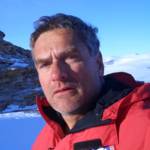
For evidence of life elsewhere, NASA's Chris McKay (pictured) says, "Ultimately, you'll have to have a body." Of course, we think Richard Hoover has already produced a body in the form of fossilized germs in carbonaceous meteorites. The review is wide-ranging and enjoyable.
 Heidi Ledford, "Life-changing experiments: The biological Higgs" [html], Nature.com, 28 Mar 2012. Heidi Ledford, "Life-changing experiments: The biological Higgs" [html], Nature.com, 28 Mar 2012.
 Thanks for the alert, Stan Franklin. Thanks for the alert, Stan Franklin.
 The RNA World and Other Origin-of-Life Theories has updates since 1998. The RNA World and Other Origin-of-Life Theories has updates since 1998.
 Fossilized bacteria in meteorites...: Hoover's evidence, 3 Mar 2011. Fossilized bacteria in meteorites...: Hoover's evidence, 3 Mar 2011.
...About 40% of all red dwarf stars have a super-Earth orbiting in the habitable zone where liquid water can exist on the surface of the planet. Because red dwarfs are so common — there are about 160 billion of them in the Milky Way — this leads us to the astonishing result that there are tens of billions of these planets in our galaxy alone. — Xavier Bonfils, Institut de Planétologie et d'Astrophysique de Grenoble, Observatoire des Sciences de l'Univers de Grenoble, France.
 X. Bonfils et al., "The HARPS search for southern extra-solar planets XXXI. The M-dwarf sample" [abstract], arXiv:1111.5019v2, 24 Nov 2011. X. Bonfils et al., "The HARPS search for southern extra-solar planets XXXI. The M-dwarf sample" [abstract], arXiv:1111.5019v2, 24 Nov 2011.
 Many billions of rocky planets in the habitable zones around red dwarfs in the Milky Way, EurekAlert! (also ScienceDaily), 28 Mar 2012. Many billions of rocky planets in the habitable zones around red dwarfs in the Milky Way, EurekAlert! (also ScienceDaily), 28 Mar 2012.
 ...'Super Earths' Abound Nearby by Sid Perkins, ScienceNow, 28 Mar 2012. ...'Super Earths' Abound Nearby by Sid Perkins, ScienceNow, 28 Mar 2012.
 Life on Europa, Other Moons, Other Planets? has links to news about other (mostly nearer) possible habitats for life. Life on Europa, Other Moons, Other Planets? has links to news about other (mostly nearer) possible habitats for life.
No theory is too special to question — Giovanni Amelino-Camelia, p125 v438, Nature, 8 Mar 2012.
Although the impact that EVEs [endogenous viral elements] have on eukaryotic genome evolution has long been appreciated, until recently, most studies in this area were limited to one or a few candidate loci. The development of high-throughput technologies is beginning to provide a genome-wide perspective on the contribution of EVEs to cellular function, and the magnitude of this contribution is exceeding even the boldest predictions. — Cédric Feschotte and Clément Gilbert
 These two self-described "paleovirologists" are initially interested in reconciling the conflicting ages of viruses given by different methods. The observed mutation rate indicates they are young, but distribution among long-diverged species suggests they are old. The two researchers conclude that viruses are old: In many cases in which EVEs that are closely related to modern viruses could be dated, the minimum age inferred for the most recent ancestor of the viral family has turned out to be far older than was previously estimated using sequence data from circulating viruses.
These two self-described "paleovirologists" are initially interested in reconciling the conflicting ages of viruses given by different methods. The observed mutation rate indicates they are young, but distribution among long-diverged species suggests they are old. The two researchers conclude that viruses are old: In many cases in which EVEs that are closely related to modern viruses could be dated, the minimum age inferred for the most recent ancestor of the viral family has turned out to be far older than was previously estimated using sequence data from circulating viruses.
For our part, we want to know how viruses affect evolution. Feschotte and Gilbert notice a lot about that as well: Population genetics predict that, for every fixed EVE insertion, thousands must have occurred in germ cells but were lost from the host population. Nonetheless: Nearly half a million viral insertions have reached fixation in the human genome alone, whereas many more have concurrently colonized other vertebrate lineages.
Examples abound in the literature of ERV-derived sequences that have been incorporated into the 'normal' regulation of mammalian genes, most frequently as promoters, enhancers or polyadenylation signals. ...There are circumstances in which viral gene products have been usefully recruited by the host. ...Through various interactions, viruses have profoundly influenced the evolution of cellular life ever since its origin. This review paper merits your attention.

 Cédric Feschotte and Clément Gilbert, "Endogenous viruses: insights into viral evolution and impact on host biology" [abstract], doi:10.1038/nrg3199, p283-296 v13, Nature Reviews Genetics, Apr 2012. Cédric Feschotte and Clément Gilbert, "Endogenous viruses: insights into viral evolution and impact on host biology" [abstract], doi:10.1038/nrg3199, p283-296 v13, Nature Reviews Genetics, Apr 2012.
Surprisingly, it appears that not just retroviruses but almost all types of viruses can become endogenous.
 The Feschotte Lab, now at the University of Utah School of Medicine. The Feschotte Lab, now at the University of Utah School of Medicine.
 Viruses and Other Gene Transfer Mechanisms is the main related local webpage. Viruses and Other Gene Transfer Mechanisms is the main related local webpage.
What'sNEW about HGT  | |
 Metazoan Genes Older Than Metazoa? has many examples of genes older than they should be in a strictly darwinian world. Metazoan Genes Older Than Metazoa? has many examples of genes older than they should be in a strictly darwinian world.
 Human Genome Search... is a related local webpage. Human Genome Search... is a related local webpage.
 ...we must begin seriously to consider whether the course of Evolution can at all reasonably be represented as an unpacking of an original complex which contained within itself the whole range of diversity which living things present. — William Bateson, in the Presidential Address at the Australian meeting of the British Association for the Advancement of Science, 1914.
...we must begin seriously to consider whether the course of Evolution can at all reasonably be represented as an unpacking of an original complex which contained within itself the whole range of diversity which living things present. — William Bateson, in the Presidential Address at the Australian meeting of the British Association for the Advancement of Science, 1914.
Almost a hundred years ago, this distinguished biologist proposed the radical idea that life comes with all of its diversity already available, originally. (The idea is more radical now than it was then, before big bang orthodoxy became dominant in the second half of the twentieth century.)
Interestingly, the opening quotation begins with a dependent clause, If then we have to dispense, as seems likely, with any addition from without.... In his day, the theory that life on Earth could arrive from space was little considered, because space was believed to be completely hostile to life. But at least he mentions the possibility. The idea of "evolution as an upacking of an original complex" that comes from "without" (space) — we call that cosmic ancestry.
|
...as we have got to recognise that there has been an Evolution, that somehow or other the forms of life have arisen from fewer forms, we may as well see whether we are limited to the old view that evolutionary progress is from the simple to the complex, and whether after all it is conceivable that the process was the other way about. |
|
 William Bateson, "Presidential Address" [meeting transcript: search page for Having in view these | local excerpt], British Association for the Advancement of Science, Melbourne Australia, 14 Aug 1914. William Bateson, "Presidential Address" [meeting transcript: search page for Having in view these | local excerpt], British Association for the Advancement of Science, Melbourne Australia, 14 Aug 1914.
 Roger Sansom, Ingenious Genes, MIT Press, 2011.
Bateson could not fathom the addition of inherited factors or mutations that improved their function. Roger Sansom, Ingenious Genes, MIT Press, 2011.
Bateson could not fathom the addition of inherited factors or mutations that improved their function.
 Genes Older Than Earth? is a possibly-related local webpage. Genes Older Than Earth? is a possibly-related local webpage.
 The Beginning is a related local webpage naming others who entertained early versions of strong panspermia – a term we have abandoned in favor of simply, "cosmic ancestry." The Beginning is a related local webpage naming others who entertained early versions of strong panspermia – a term we have abandoned in favor of simply, "cosmic ancestry."
 Bateson: We have done with the notion ...that large differences can arise by accumulation of small differences. Bateson: We have done with the notion ...that large differences can arise by accumulation of small differences.
 Weldon, Bateson, and the origins of genetics: Reflections on the unraveling and rebuilding of a scientific community by Lea K. Davis, PLoS Gen, 27 Oct 2022. Weldon, Bateson, and the origins of genetics: Reflections on the unraveling and rebuilding of a scientific community by Lea K. Davis, PLoS Gen, 27 Oct 2022.
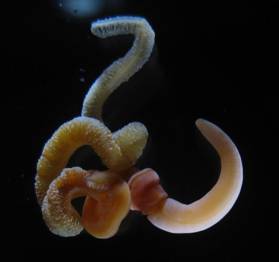 "The origin of the exquisitely complex vertebrate brain is somewhat mysterious. 'In terms of evolution, it basically pops up out of nowhere. You don’t see anything anatomically like it in other animals,' says Ariel Pani, an investigator at the Marine Biological Laboratory (MBL) in Woods Hole and a graduate student at the University of Chicago.
"The origin of the exquisitely complex vertebrate brain is somewhat mysterious. 'In terms of evolution, it basically pops up out of nowhere. You don’t see anything anatomically like it in other animals,' says Ariel Pani, an investigator at the Marine Biological Laboratory (MBL) in Woods Hole and a graduate student at the University of Chicago.
But this week..., Pani and colleagues report finding some of the genetic processes that regulate vertebrate brain development in (of all places) the acorn worm (pictured), a brainless, burrowing marine invertebrate.... "
Biologists from the University of Chicago and Stanford University conclude that genes containing programs for aspects of vertebrate brain development were present among some species that existed long before the appearance of vertebrates. Although it may not, this news should astound darwinists. How does darwinism account for genes that entirely precede the features they encode?
For cosmic ancestry this news is a confirmation, because genes always come first.
 Ariel M. Pani, Erin E. Mullarkey, Jochanan Aronowicz, Stavroula Assimacopoulos, Elizabeth A. Grove, Christopher J. Lowe, "Ancient deuterostome origins of vertebrate brain signalling centres" [abstract], doi:10.1038/nature10838, p289-294 v483, Nature, 15 Mar 2012. Ariel M. Pani, Erin E. Mullarkey, Jochanan Aronowicz, Stavroula Assimacopoulos, Elizabeth A. Grove, Christopher J. Lowe, "Ancient deuterostome origins of vertebrate brain signalling centres" [abstract], doi:10.1038/nature10838, p289-294 v483, Nature, 15 Mar 2012.
 An Evolutionary Surprise: In a brainless marine worm, MBL researchers find the developmental 'scaffold' for the vertebrate brain, Marine Biological Laboratory (also ScienceDaily), 14 Mar 2012. An Evolutionary Surprise: In a brainless marine worm, MBL researchers find the developmental 'scaffold' for the vertebrate brain, Marine Biological Laboratory (also ScienceDaily), 14 Mar 2012.
 Metazoan Genes
Older Than Metazoa? lists many more examples of genes that apparently come first. Metazoan Genes
Older Than Metazoa? lists many more examples of genes that apparently come first.
 Testing Darwinism versus Cosmic Ancestry discusses this genomic-analysis method of reconstructing the past. Testing Darwinism versus Cosmic Ancestry discusses this genomic-analysis method of reconstructing the past.
 Genes Older Than Earth? is a possibly related local webpage. Genes Older Than Earth? is a possibly related local webpage.
 Thanks for an alert, Ken Jopp. Thanks for an alert, Ken Jopp.
The RNA World theory is disputed following a new phylogenetic analysis. In the standard theory, today's ribosomes were preceded by a primitive, RNA-only version, somehow capable of catalyzing the production of the first proteins. The new analysis casts doubt on this scenario. "Although a primitive ribosome composed solely of RNA has been proposed, it is unlikely that such a complex RNA machine could have existed." It could hardly work anyway, they add.
In the new proposal, some of the proteins that are complexed with today's ribosomes were apparently recruited contemporaneously with the RNA components. The two researchers observe that independently generated phylogenies of ribosomal proteins and ribosomal RNAs show "great congruence" with one another. "We propose complex ribosomal functionality emerged from the cooperative interaction of rRNA and r-proteins (or their precursors), which existed from the earliest stages of ribosome evolution," says senior team member Gustavo Caetano-Anollés, a botanical geneticist at the University of Illinois, Urbana-Champaign.
If the evolutionary build-up of ribosomal proteins and RNA and the interactions between them occurred gradually, step-by-step, the origin of the ribosome cannot be the product of an RNA world. Instead, it must be the product of a ribonucleoprotein world, an ancient world that resembles our own. It appears the basic building blocks of the machinery of the cell have always been the same from the beginning of life to the present: evolving and interacting proteins and RNA molecules.
— Gustavo Caetano-Anollés | |
Also in this analysis, the two major subunits of the ribosome must have functioned independently at some earlier time (not shown in illustration). Chronologically, "We find that components of the small subunit involved in ribosomal processivity evolved earlier than the catalytic peptidyl transferase center responsible for protein synthesis."
A problem for this proposal is to explain how proteins were made before there were ribosomes to make them. The researchers propose, "The very early peptide chains were most likely synthesized by primitive means, perhaps through autocatalysis and/or non-ribosomal peptide synthesis, since modern ribosomal translation had not yet evolved."
The report is consistent with darwinian philosophy, which assumes that life originated from nonliving chemicals and evolved through many stages before there were cells. We suggest that without these assumptions other interpretations of the data might emerge (as hinted in box at right.) In any case, the research is comprehensive and the accompanying illustrations alone are worth seeing. Meanwhile, here's another contender among origin-of-life theories.
 Ajith Harish and Gustavo Caetano-Anollés, "Ribosomal History Reveals Origins of Modern Protein Synthesis" [html], doi:10.1371/journal.pone.0032776, PLoS ONE 7(3): e32776, 12 Mar 2012. Ajith Harish and Gustavo Caetano-Anollés, "Ribosomal History Reveals Origins of Modern Protein Synthesis" [html], doi:10.1371/journal.pone.0032776, PLoS ONE 7(3): e32776, 12 Mar 2012.
 Study of ribosome evolution challenges RNA World hypothesis by Diana Yates, The University of Illinois (also PhysOrg.com), 12 Mar 2012. Study of ribosome evolution challenges RNA World hypothesis by Diana Yates, The University of Illinois (also PhysOrg.com), 12 Mar 2012.
 Thanks, Stan Franklin. Thanks, Stan Franklin.
 The RNA World... is the main related local webpage. The RNA World... is the main related local webpage.
 Genes Older Than Earth? has corroboration for Caetano-Anollés' radical suggestion, "...always been the same...." Genes Older Than Earth? has corroboration for Caetano-Anollés' radical suggestion, "...always been the same...."
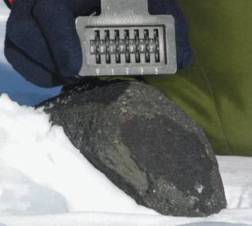 Although we've found amino acids in carbon-rich meteorites before, we weren't expecting to find them in these specific groups, since the high temperatures they experienced tend to destroy amino acids — Dr. Aaron Burton, NASA.
Although we've found amino acids in carbon-rich meteorites before, we weren't expecting to find them in these specific groups, since the high temperatures they experienced tend to destroy amino acids — Dr. Aaron Burton, NASA.
NASA's team supposes that these amino acids, found in meteorites recovered in Antarctica, were made by catalysed chemical reactions in space, even though harmful contaminants would be present. We wish NASA would at least mention the fact that life makes amino acids, and ask if they could have eventually degraded into the ones observed. Instead, NASA comments that chemically produced amino acids must be abundant in space and could provide starter ingredients for an origin-of-life almost anywhere. With resignation, we welcome this added support for pseudo-panspermia. At least it's something.
 Aaron S. Burton et al., "A propensity for n-ω-amino acids in thermally altered Antarctic meteorites" [abstract], doi:10.1111/j.1945-5100.2012.01341.x, Meteoritics & Planetary Science, online 8 Mar 2012. Aaron S. Burton et al., "A propensity for n-ω-amino acids in thermally altered Antarctic meteorites" [abstract], doi:10.1111/j.1945-5100.2012.01341.x, Meteoritics & Planetary Science, online 8 Mar 2012.
 Meteorites Reveal Another Way to Make Life's Components by Bill Steigerwald, NASA's Goddard Space Flight Center (also
PhysOrg.com), 9 Mar 2012. Meteorites Reveal Another Way to Make Life's Components by Bill Steigerwald, NASA's Goddard Space Flight Center (also
PhysOrg.com), 9 Mar 2012.
 Thanks, Stan Franklin. Thanks, Stan Franklin.
 Pseudo-panspermia and stronger versions of panspermia are defined on our webpage Panspermia Asks New Questions. Pseudo-panspermia and stronger versions of panspermia are defined on our webpage Panspermia Asks New Questions.
 Comets: The Delivery System is a related local webpage. Comets: The Delivery System is a related local webpage.
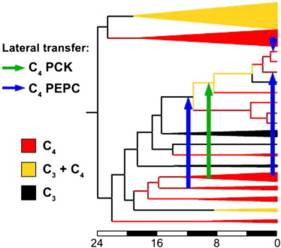 ...We show that fundamental elements of the C4 pathway in the grass lineage Alloteropsis were acquired via a minimum of four independent lateral gene transfers from C4 taxa that diverged from this group more than 20 million years ago. The transfer of genes that were already fully adapted for C4 function has occurred periodically over at least the last 10 million years and has been a recurrent source for the optimization of the C4 pathway. This report shows that plant-plant lateral nuclear gene transfers can be a potent source of genetic novelty and adaptation in flowering plants.
...We show that fundamental elements of the C4 pathway in the grass lineage Alloteropsis were acquired via a minimum of four independent lateral gene transfers from C4 taxa that diverged from this group more than 20 million years ago. The transfer of genes that were already fully adapted for C4 function has occurred periodically over at least the last 10 million years and has been a recurrent source for the optimization of the C4 pathway. This report shows that plant-plant lateral nuclear gene transfers can be a potent source of genetic novelty and adaptation in flowering plants.There is no reason to think that this mechanism would be unique to the evolution of the C4 pathway. As more genomic data accumulate for other taxa, additional cases of adaptive plant-plant nuclear gene transfers may be discovered, in a great variety of adaptive traits.
In cosmic ancestry, lateral or horizontal gene transfer (HGT) supplies the genes for new features. Mainstream darwinian theory, however, expects genes for new features to be composed by trial-and-error on a virtually blank slate, during vertical inheritance. Evidence for HGT is abundant and growing rapidly. By comparison, evidence for the mainstream account of new genes seems awfully thin. We welcome pointers to counterexamples.
 Pascal-Antoine Christin et al., "Adaptive Evolution of C4 Photosynthesis through Recurrent Lateral Gene Transfer" [abstract | pdf], doi:10.1016/j.cub.2012.01.054, p445-449 v22, Current Biology, 16 Feb 2012. Pascal-Antoine Christin et al., "Adaptive Evolution of C4 Photosynthesis through Recurrent Lateral Gene Transfer" [abstract | pdf], doi:10.1016/j.cub.2012.01.054, p445-449 v22, Current Biology, 16 Feb 2012.
 Eric H. Roalson, "C4 Photosynthesis: Need a Gene? Borrow One!" [abstract], doi:10.1016/j.cub.2012.01.043, R161-R163 v22, Current Biology, 6 Mar 2012. Eric H. Roalson, "C4 Photosynthesis: Need a Gene? Borrow One!" [abstract], doi:10.1016/j.cub.2012.01.043, R161-R163 v22, Current Biology, 6 Mar 2012.
 Guy Riddihough, "The Great Gene Giveaway" [abstract], doi:10.1126/science.335.6073.1149-a, p1149 v335, Science, 9 Mar 2012. Guy Riddihough, "The Great Gene Giveaway" [abstract], doi:10.1126/science.335.6073.1149-a, p1149 v335, Science, 9 Mar 2012.
 Viruses and Other Gene Transfer Mechanisms is the main related local webpage. Search for "photosynthesis". Viruses and Other Gene Transfer Mechanisms is the main related local webpage. Search for "photosynthesis".
What'sNEW about HGT  | |
 Macroevolutionary Progress Redefined: Can It Happen Without Gene Transfer? is a related local webpage. Macroevolutionary Progress Redefined: Can It Happen Without Gene Transfer? is a related local webpage.
 New genetic programs in Darwinism and strong panspermia describes a test, proposed ten years ago, to compare the two alternatives. New genetic programs in Darwinism and strong panspermia describes a test, proposed ten years ago, to compare the two alternatives.
  Julian M. Hibberd and Robert T. Furbank, "In retrospect: Fifty years of C4 photosynthesis" [link], doi:10.1038/538177b, Nature, 13 Oct 2016. Despite the high complexity of the C4 system, it has evolved independently many times, and the number of unrelated groups of C4 plants has grown steadily, to around 61 lineages.... Julian M. Hibberd and Robert T. Furbank, "In retrospect: Fifty years of C4 photosynthesis" [link], doi:10.1038/538177b, Nature, 13 Oct 2016. Despite the high complexity of the C4 system, it has evolved independently many times, and the number of unrelated groups of C4 plants has grown steadily, to around 61 lineages....
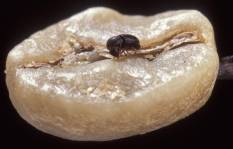 An insect species acquired a beneficial gene from bacteria by horizontal gene transfer (HGT). Coffee berry borer beetles (example on a bean, pictured) harbor the bacteria in their guts. The acquired gene enables the beetle to digest complex sugars in the beans. In standard evolutionary theory, this phenomenon is considered remarkable, whereas in cosmic ancestry, HGT is necessary to drive evolutionary progress. And this example is only one among many noticed in the last few decades. We wish standard evolutionary theory would pay more attention.
An insect species acquired a beneficial gene from bacteria by horizontal gene transfer (HGT). Coffee berry borer beetles (example on a bean, pictured) harbor the bacteria in their guts. The acquired gene enables the beetle to digest complex sugars in the beans. In standard evolutionary theory, this phenomenon is considered remarkable, whereas in cosmic ancestry, HGT is necessary to drive evolutionary progress. And this example is only one among many noticed in the last few decades. We wish standard evolutionary theory would pay more attention.
 Ricardo Acuña, Beatriz E. Padilla et al., "Adaptive horizontal transfer of a bacterial gene to an invasive insect pest of coffee" [abstract], doi:10.1073/pnas.1121190109, Proc. Natl. Acad. Sci. USA, online 27 Feb 2012. Ricardo Acuña, Beatriz E. Padilla et al., "Adaptive horizontal transfer of a bacterial gene to an invasive insect pest of coffee" [abstract], doi:10.1073/pnas.1121190109, Proc. Natl. Acad. Sci. USA, online 27 Feb 2012.
 Bacterial gene helps coffee beetle get its fix by Melissa Lee Phillips, Nature News, 27 Feb 2012. Bacterial gene helps coffee beetle get its fix by Melissa Lee Phillips, Nature News, 27 Feb 2012.
 Coffee Pest Gene Transfer by Hannah Waters, The Scientist, 27 Feb 2012. Coffee Pest Gene Transfer by Hannah Waters, The Scientist, 27 Feb 2012.
 Rare bacteria-to-animal gene transfer offers evolutionary advantage to coffee pest by Krishna Ramanujan, Cornell Chronicle Online, 29 Feb 2012. Rare bacteria-to-animal gene transfer offers evolutionary advantage to coffee pest by Krishna Ramanujan, Cornell Chronicle Online, 29 Feb 2012.
 Viruses and Other Gene Transfer Mechanisms lists hundreds of examples of beneficial HGT, many of which are cross-kingdom. Viruses and Other Gene Transfer Mechanisms lists hundreds of examples of beneficial HGT, many of which are cross-kingdom.
What'sNEW about HGT  | |
 Thanks for alerts, Stan Franklin and Jack Foster, iii. Thanks for alerts, Stan Franklin and Jack Foster, iii.
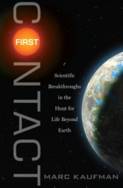 First Contact, by Washington Post science reporter Marc Kaufman, is well worth reading. He is genuinely interested in the possibility of life elsewhere, and he digs deeply into the details. To do this, he has spent time with many of the frontline researchers, and he shares those experiences vividly. The researchers come from a variety of fields, like extremophiles, SETI, extrasolar planets and, of course, life on Mars. We enjoyed learning more, for example, about Michael Mumma and his painstaking detection of methane on Mars. And we especially liked Chapter 6: "Three Eurekas on Hold," about the discoveries of David McKay, Richard Hoover and Gil Levin. We know them well, and think all three deserve to be better understood. Here Kaufman is a bit too even-handed for us, but that keeps him from seeming prejudicial, so, good. Recommended.
First Contact, by Washington Post science reporter Marc Kaufman, is well worth reading. He is genuinely interested in the possibility of life elsewhere, and he digs deeply into the details. To do this, he has spent time with many of the frontline researchers, and he shares those experiences vividly. The researchers come from a variety of fields, like extremophiles, SETI, extrasolar planets and, of course, life on Mars. We enjoyed learning more, for example, about Michael Mumma and his painstaking detection of methane on Mars. And we especially liked Chapter 6: "Three Eurekas on Hold," about the discoveries of David McKay, Richard Hoover and Gil Levin. We know them well, and think all three deserve to be better understood. Here Kaufman is a bit too even-handed for us, but that keeps him from seeming prejudicial, so, good. Recommended.
 Marc Kaufman, First Contact: Scientific Breakthroughs in the Hunt for Life Beyond Earth [publisher's promo], ISBN: 9781439109014, Simon & Schuster, Apr 2011. "If life is found on Mars or Europa.... Feeling at home in nature suddenly has a very different, much bigger meaning" (p14). Marc Kaufman, First Contact: Scientific Breakthroughs in the Hunt for Life Beyond Earth [publisher's promo], ISBN: 9781439109014, Simon & Schuster, Apr 2011. "If life is found on Mars or Europa.... Feeling at home in nature suddenly has a very different, much bigger meaning" (p14).
Experimenters with a virus and its bacterial host in a quarantined system report a breakthrough. Five nucleotide substitutions in one of the virus's genes allowed it to infect the host species through a novel pathway. Four of the five were shown to be essential.
We have long thought that "immune warfare" like this is analogous to code-breaking and the defenses against it. Code-breaking uses exhaustive search to find the combination or key, and the best defense is frequently-changed keys. Those cyber-activities do nothing that would compose new programs for new features.
"Mutations in the λ gene encoding the J protein in three isolates from the same population on day 8 of the initial evolution experiment. The isolates are shown in rows and the mutations in columns, with the first letter being the ancestral nucleotide, the number the nucleotide position, and the last letter the evolved nucleotide. The gray fill indicates that the phage isolate has the corresponding mutation." | |
However, the molecular biologists conducting this experiment, including Richard Lenski and members of his group at Michigan State University, think more has happened. They believe that host-recognition proteins on the surface of a virus are analogous to the full multitude of enzymes catalyzing all of the reactions in life. If so, a newly evolved one would illustrate how all of those enzymes could have evolved.
In this case anyway, we suspect not. If, for example, the observed phenomenon of "directed mutation" were acting on the correct 5 nucleotides, only 4^5 = 1,024 trials would likely produce the needed combination of mutations. If it were focussed even on ten nucleotides (4^10 = about a million), the right combination might still be within reach. (To us, directed mutation is further implicated in this experiment, because out of 40 mutations that became fixed in the alleles of the subject gene —most of them several times— all were nonsynonymous. If the mutations were strictly random, this is highly unlikely.) In our opinion, this change would fall into the category of microevolution, which is capable of code-breaking, of which this development appears to be an example.
This evolution is quite different, we believe, from the discovery of most of life's enzymes. In general, each enzyme exists in a family which is itself removed from other families by, not 5 or 10, but up to hundreds of nucleotide substitutions, additions or deletions. That means that the number of needed trials to probably derive a new one from an existing one could be 4^hundreds = far too many.
The report begins, "The processes responsible for the evolution of key innovations, whereby lineages acquire qualitatively new functions that expand their ecological opportunities, remain poorly understood." Later it states, "...Natural selection is critical for the process of adaptation, yet its role in producing key innovations is less clear because, by fixing variants that improve existing functions, selection might strand populations on local adaptive peaks and thereby prevent them from discovering new functions." Apparently, not everyone had gotten the word before now.
We should mention that the article is largely about coevolution between the virus and its host, on which we scarcely comment. For an analysis that comments fully on it, by an expert in biochemistry, we recommend Michael Behe's, linked below. Finally, we think that quarantined experiments in biology are the best way to explore the power and range of strictly darwinian evolution in life, and that Richard Lenski's group conducts the best ones of them. That's why we pay attention to their reports.
 Justin R. Meyer et al., "Repeatability and Contingency in the Evolution of a Key Innovation in Phage Lambda" [abstract], doi:10.1126/science.1214449, p428-432 v335, Science, 27 Jan 2012. Justin R. Meyer et al., "Repeatability and Contingency in the Evolution of a Key Innovation in Phage Lambda" [abstract], doi:10.1126/science.1214449, p428-432 v335, Science, 27 Jan 2012.
 John N. Thompson, "The Role of Coevolution" [summary], doi:10.1126/science.1217807, p410-411 v335, Science, 27 Jan 2012. John N. Thompson, "The Role of Coevolution" [summary], doi:10.1126/science.1217807, p410-411 v335, Science, 27 Jan 2012.
 One Small Step Sideways, Two Huge Steps Back by Michael Behe, 31 Jan 2012. One Small Step Sideways, Two Huge Steps Back by Michael Behe, 31 Jan 2012.
 Study Finds Virus to Be Fast Learner on Infecting by Carl Zimmer, The New York Times, 26 Jan (in print 27 Jan) 2012. Study Finds Virus to Be Fast Learner on Infecting by Carl Zimmer, The New York Times, 26 Jan (in print 27 Jan) 2012.
 In Real or Artificial Life, Is Evolutionary Progress in a Closed System Possible? is a related local webpage with a special What'sNEW section linking to more about Lenski's work. In Real or Artificial Life, Is Evolutionary Progress in a Closed System Possible? is a related local webpage with a special What'sNEW section linking to more about Lenski's work.
 Macroevolutionary Progress Redefined: Can It Happen Without Gene Transfer? is a local webpage with more about the definition of microevolution. Macroevolutionary Progress Redefined: Can It Happen Without Gene Transfer? is a local webpage with more about the definition of microevolution.
 Does Microevolution Explain Macroevolution? is a related section of our Neo-Darwinism... webpage. Does Microevolution Explain Macroevolution? is a related section of our Neo-Darwinism... webpage.
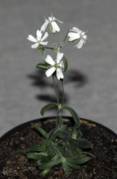 Plant tissue frozen in Siberia for 32,000 years has been revived to produce a flowering plant bearing viable seeds. The tissue came from fruit stored in the burrow of an arctic ground squirrel; radiocarbon dating confirms the age of the tissue. The plant, a campion (pictured), is being cultivated by bologists at the Institutes of Cell Biophysics and Physicochemical and Biological Problems in Soil Science at the Russian Academy of Sciences. They write, This revival reinforces other evidence showing that dormant life can remain viable for very long times...."
Plant tissue frozen in Siberia for 32,000 years has been revived to produce a flowering plant bearing viable seeds. The tissue came from fruit stored in the burrow of an arctic ground squirrel; radiocarbon dating confirms the age of the tissue. The plant, a campion (pictured), is being cultivated by bologists at the Institutes of Cell Biophysics and Physicochemical and Biological Problems in Soil Science at the Russian Academy of Sciences. They write, This revival reinforces other evidence showing that dormant life can remain viable for very long times...."
 Svetlana Yashina et al., "Regeneration of whole fertile plants from 30,000-y-old fruit tissue buried in Siberian permafrost" [abstract], doi:10.1073/pnas.111838610, Proc. Nat. Acad. Sci., USA, online 21 Feb 2012. Svetlana Yashina et al., "Regeneration of whole fertile plants from 30,000-y-old fruit tissue buried in Siberian permafrost" [abstract], doi:10.1073/pnas.111838610, Proc. Nat. Acad. Sci., USA, online 21 Feb 2012.
 Russians regenerate flowering plant from 30,000-year-old frozen burrow of Ice Age squirrel by Associated Press, The Washington Post, 20 Feb 2012. Russians regenerate flowering plant from 30,000-year-old frozen burrow of Ice Age squirrel by Associated Press, The Washington Post, 20 Feb 2012.
 Thanks, George Stratton, the Memphis Commecial Appeal, Polly Klyce Pennoyer and Esther Pearson. Thanks, George Stratton, the Memphis Commecial Appeal, Polly Klyce Pennoyer and Esther Pearson.

Methane concentrations observed in martian autumn, and a true colour map of Mars (NASA/Università del Salento.) |
Methane on Mars is the subject of controversy at NASA. Michael J. Mumma of the Goddard Space Flight Center is sure the methane is actually there, being supplied, and somehow consumed, at a surprisingly high rate. But Kevin Zahnle of NASA's Ames Research Center finds the reports "extraordinary."
"The answer might come from NASA's Mars Science Laboratory rover, called Curiosity, scheduled to land on Mars in August 2012, carrying with it the Sample Analysis at Mars (SAM) suite, which will measure a multitude of trace constituents and isotopes from gas and solid samples. ...A more comprehensive test is planned in 2016 with the ExoMars Trace Gas Orbiter (TGO), which will be part of the joint ESA/NASA dual mission ExoMars Program. The TGO will scan the atmosphere for exotic trace gases, such as methane."
Of course, we think Mars' methane could come from methanogenic life there.
 NASA: "The Conditions for the Emergence of Life were Present on Mars – Period, End of Story", The Daily Galaxy, 17 Feb 2012. NASA: "The Conditions for the Emergence of Life were Present on Mars – Period, End of Story", The Daily Galaxy, 17 Feb 2012.
 Life on Mars! is a related local webpage. Search for "methane". Life on Mars! is a related local webpage. Search for "methane".
 Thanks, Stan Franklin. Thanks, Stan Franklin.
Dimitar Sasselov's The Life of Super-Earths is a delight to read. Soon after starting it I began to smile, and I smiled every time I opened it. The writing is engaging, straightforward and entirely comprehensible for non-scientists. Yet it is full of deep and surprising insights.
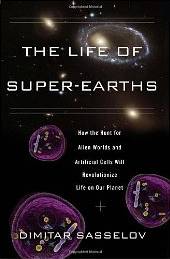
Earthlike extrasolar planets are one of Sasselov's specialties, and he easily gets the reader up to speed about them by recounting the relevant developments in history, chemistry, astronomy and other related fields. I thought I already knew this stuff, but I had never heard of, for example, ice VII, ice X and ice XI that are denser than liquid water and would be found on oceanic super-Earths.
Most of the extrasolar planets discovered so far are gas giants, like Jupiter. These would be unlikely to harbor life, at least not life as we know it. Our kind of life needs minerals and a variety of things found only on rocky, "Earthlike" planets. That's why they especially interest Sasselov. And he has helped to pioneer methods for detecting them. Beyond finding them, he has thought deeply about how life would flourish on them. He concludes that life would have an easier time on ones that are larger than Earth — hence, "super-Earths."
Sasselov also knows big bang cosmology thoroughly, and describes the universe as "young." If so, the minerals needed for life are even younger, and life must originate from nonlife, as is the consensus. He overrates the progress of the RNA World, writing, "RNA ...is capable of catalyzing its own replication" (p136). At best, these would be very short strands, in entirely unnatural environments. And he says nothing about the software aspect of the origin-of-life problem, but this is wise, because there is nothing to say. Notably, he finds interplanetary panspermia "quite plausible" (p157).
 Hubble Reveals a New Type of Planet, Harvard-Smithsonian Center for Astrophysics, 21 Feb 2012: Hubble Reveals a New Type of Planet, Harvard-Smithsonian Center for Astrophysics, 21 Feb 2012:
"Our solar system contains three types of planets: rocky, terrestrial worlds (Mercury, Venus, Earth, and Mars), gas giants (Jupiter and Saturn), and ice giants (Uranus and Neptune). Planets orbiting distant stars come in an even wider variety, including lava worlds and 'hot Jupiters.' ...[A] new type of planet...GJ1214b... is a waterworld enshrouded by a thick, steamy atmosphere." |
Finally he promotes synthetic biology as one of the three great milestones in human history. Now we can create a new kind of life with its own separate tree. His enthusiasm for it is palpable. In all, the book tells an enjoyable, entertaining, informative story. I am going to read it again.
Dimitar Sasselov is a Professor of Astronomy at Harvard University and the founding director of the Harvard Origins of Life Initiative.
 Dimitar Sasselov, The Life of Super-Earths: How the Hunt for Alien Worlds and Artificial Cells Will Revolutionize Life on Our Planet [publisher's promo], ISBN-10: 046502193X, 240 pages, Basic Books, 24 Jan 2012. Dimitar Sasselov, The Life of Super-Earths: How the Hunt for Alien Worlds and Artificial Cells Will Revolutionize Life on Our Planet [publisher's promo], ISBN-10: 046502193X, 240 pages, Basic Books, 24 Jan 2012.
 Dimitar Sasselov discusses his book..., Harvard Book Store, 17 Feb 2012. Dimitar Sasselov discusses his book..., Harvard Book Store, 17 Feb 2012.
 Thanks for a link, Pam Pacelli. Thanks for a link, Pam Pacelli.
 Instruments, Methods, and Missions for Astrobiology XV, sponsored by SPIE, the international society for optics and photonics, will be held in San Diego, 12-16 August. Conference Chairs are Richard B. Hoover, NASA Marshall Space Flight Center.; Gilbert V. Levin, Arizona State University; Alexei Yu. Rozanov, Paleontological Institute (Russian Federation); and Paul C. W. Davies, Arizona State University.
Instruments, Methods, and Missions for Astrobiology XV, sponsored by SPIE, the international society for optics and photonics, will be held in San Diego, 12-16 August. Conference Chairs are Richard B. Hoover, NASA Marshall Space Flight Center.; Gilbert V. Levin, Arizona State University; Alexei Yu. Rozanov, Paleontological Institute (Russian Federation); and Paul C. W. Davies, Arizona State University.
 Instruments, Methods, and Missions for Astrobiology XV, San Diego Convention Center, San Diego CA, USA, 12-16 Aug 2012. Instruments, Methods, and Missions for Astrobiology XV, San Diego Convention Center, San Diego CA, USA, 12-16 Aug 2012.
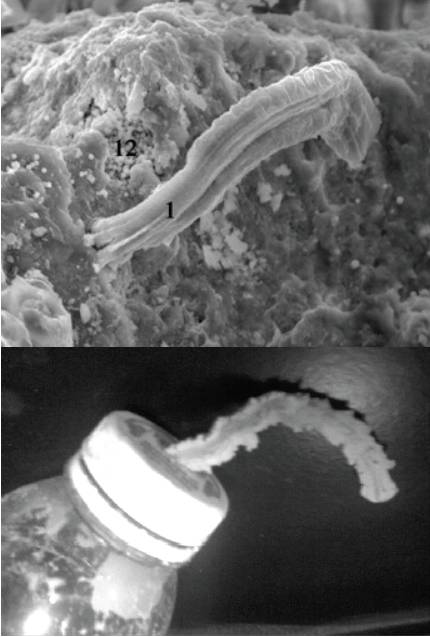
Figure 1: Extruded morphology of "microbes". Top: Image adapted from Figure 2a of Hoover (2011) showing purported extraterrestrial microbe. Bottom: Image of clay extruded from a homemade extruder showing similar morphology. "Microbes" are extruded from the porous CI matrix as sulfides alter to sulfates under the influence of ambient humidity. Image credit: Lauren Vork, www.ehow.com |
Evidence for microfossils in meteorites gets a laughable rebuttal from the Planetary Sciences Institute. The evidence comes from Richard Hoover's paper, "Fossils of Cyanobacteria in CI1 Carbonaceous Meteorites..." published online 3 Mar 2011. The rebuttal comes from a poster by PSI member Marc Fries, presented today at the PSI conference in San Diego. (Both are linked below.)
The poster isolates a single filament cropped from one of Hoover's photographs, while the original, uncropped FESEM image shows a dozen or so filaments. These have sizes and detailed morphologies that are consistent with known genera and species of cyanobacteria — far more convincing evidence than a single filament. But Fries compares this one (top) to an extrusion of clay squeezed through the perforated cap of a plastic soda bottle (bottom).
The cropping from Hoover's photo also omits the scale bar, allowing the clay extrusion to look smaller, although it is actually larger by three orders of magnitude. If the clay extrusion were imaged with a Scanning Electron Microscope at comparable magnification and resolution, the superfucial resenblance would vanish entirely. Yet, following this comparison, Fries claims that the microfossils in Orgueil, which Hoover interprets as the remains of cyanobacteria, are merely extrusions from magnesium sulfate veins in the stone. It is hard to take this criticism seriously. We think Fries must be joking.
Richard Hoover's photographs of fossilized microorganisms in carbonaceous meteorites have been studied by the world's leading experts on cyanobacteria and micropaleontology and identified as biological. NASA astrobiologist Chris McKay, for one, commented, "If these structures had been reported from sediments from a lake bottom there would be no question that they were classified correctly as biological remains." We urge anyone who may be curious to look closely at the full evidence.
 Marc Fries, "'Life in CI Chondrites': Not Life, Not Extraterrestrial, Not Even Interesting." [6035.pdf], presented at the Planetary Sciences Institute's Conference on Life Detection in Extraterrestrial Samples, San Diego CA, 12-15 Feb 2012. Marc Fries, "'Life in CI Chondrites': Not Life, Not Extraterrestrial, Not Even Interesting." [6035.pdf], presented at the Planetary Sciences Institute's Conference on Life Detection in Extraterrestrial Samples, San Diego CA, 12-15 Feb 2012.
 Richard B. Hoover, "Fossils of Cyanobacteria in CI1 Carbonaceous Meteorites: Implications to Life on Comets, Europa, and Enceladus" [41-page PDF, 3.9Mb], v13, Journal of Cosmology, online 3 Mar 2011. Richard B. Hoover, "Fossils of Cyanobacteria in CI1 Carbonaceous Meteorites: Implications to Life on Comets, Europa, and Enceladus" [41-page PDF, 3.9Mb], v13, Journal of Cosmology, online 3 Mar 2011.
 Fossilized bacteria in meteorites are obvious, our What'sNEW notice of Richard Hoover's 2011 JoC paper, with the full photo from which Fries took a cropping, and links to the JoC paper and to earlier postings about Hoover's work, 3 Mar 2011. Fossilized bacteria in meteorites are obvious, our What'sNEW notice of Richard Hoover's 2011 JoC paper, with the full photo from which Fries took a cropping, and links to the JoC paper and to earlier postings about Hoover's work, 3 Mar 2011.
 ...No question..., our What'sNEW notice with Chris McKay's quotation and reference, 11 Mar 2011. ...No question..., our What'sNEW notice with Chris McKay's quotation and reference, 11 Mar 2011.
Imaginative question:
 Do Alien Civilizations Inevitably 'Go Green'? by Paul Scott Anderson, Universe Today, 8 Feb 2012. Do Alien Civilizations Inevitably 'Go Green'? by Paul Scott Anderson, Universe Today, 8 Feb 2012.
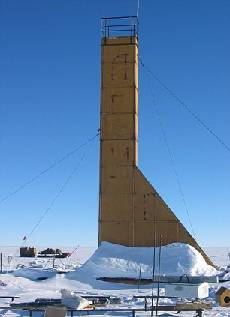 A Russian team drilling in Antarctica reached the water of Lake Vostok at a depth of 12,366 feet (3,769 meters) on Sunday. About the size of Lake Ontario, the lake has been trapped in the cold and dark under ice for some 20 million years. So isolated, its environment is comparable to that under the ice on Jupiter's moon Europa or Saturn's Enceladus. If evidence of life is found in the water of Lake Vostok, life in the oceans on those moons and elsewhere in the universe will seem more likely.
A Russian team drilling in Antarctica reached the water of Lake Vostok at a depth of 12,366 feet (3,769 meters) on Sunday. About the size of Lake Ontario, the lake has been trapped in the cold and dark under ice for some 20 million years. So isolated, its environment is comparable to that under the ice on Jupiter's moon Europa or Saturn's Enceladus. If evidence of life is found in the water of Lake Vostok, life in the oceans on those moons and elsewhere in the universe will seem more likely.
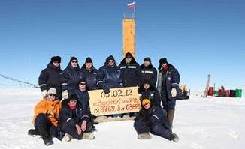 The drilling took 20 years, and preventing contamination of the lake was a major concern. When the lake was penetrated, water rushed upward into the borehole as expected, flushing the drilling fluid and its potential contamnants away. This water then quickly froze, sealing contaminants out. The testing of water samples is postponed until spring returns to Antarctica.
The drilling took 20 years, and preventing contamination of the lake was a major concern. When the lake was penetrated, water rushed upward into the borehole as expected, flushing the drilling fluid and its potential contamnants away. This water then quickly froze, sealing contaminants out. The testing of water samples is postponed until spring returns to Antarctica.
 Drilling successful as scientists break through into lake buried miles under Antarctic ice by Rob Cooper and Thomas Durante, The Daily Mail, 9 Feb 2012. Drilling successful as scientists break through into lake buried miles under Antarctic ice by Rob Cooper and Thomas Durante, The Daily Mail, 9 Feb 2012.
 Lake Vostok, Antarctica's Hidden Lake, Reached By Russia, AP, Huffington Post, 8 Feb 2012. Lake Vostok, Antarctica's Hidden Lake, Reached By Russia, AP, Huffington Post, 8 Feb 2012.
 Russians Drill Into Subglacial Antarctic Lake Vostok by Carolyn Gramling, ScienceInsider, 8 Feb 2012. Russians Drill Into Subglacial Antarctic Lake Vostok by Carolyn Gramling, ScienceInsider, 8 Feb 2012.
 In scientific coup, Russians reach Antarctic lake by Vladimir Isachankov, AP, Physorg.com, 8 Feb 2012. In scientific coup, Russians reach Antarctic lake by Vladimir Isachankov, AP, Physorg.com, 8 Feb 2012.
 Lake Vostok, Antarctica's Largest Subglacial Body Of Water, Reportedly Drilled By Russians, Huffington Post, 6 Feb 2012. Lake Vostok, Antarctica's Largest Subglacial Body Of Water, Reportedly Drilled By Russians, Huffington Post, 6 Feb 2012.
 Scientists close to entering Vostok, Antarctica's biggest subglacial lake by Marc Kaufman, The Washington Post, 31 Jan 2012. Scientists close to entering Vostok, Antarctica's biggest subglacial lake by Marc Kaufman, The Washington Post, 31 Jan 2012.
 Life on Europa, Other Moons, Other Planets? is a related local webpage. Life on Europa, Other Moons, Other Planets? is a related local webpage.
 Carolyn Gramling, "A Tiny Window Opens Into Lake Vostok, While a Vast Continent Awaits" [summary], p788-789 v335, Science, 17 Feb 2012. Carolyn Gramling, "A Tiny Window Opens Into Lake Vostok, While a Vast Continent Awaits" [summary], p788-789 v335, Science, 17 Feb 2012.
 Thanks for an alert and a link, Stan Franklin. Thanks for an alert and a link, Stan Franklin.
Recent gravitational microlensing observations predict a vast population of free-floating giant planets that outnumbers main sequence stars almost twofold. This sentence introduces a study by a British and a French astronomer who want to better account for the manner in which these planets are expelled from their original orbits. The existence of free-floating planets, apparently, was fairly accepted already, but it comes as news to us. We are amazed. If free-floating planets are so common, they would rival comets as bodies able to contain, protect and transfer dormant life across galaxies.
 Dimitri Veras and Sean N. Raymond, "Planet-planet scattering alone cannot explain the free-floating planet population" [pdf], Mon. Not. R. Astron. Soc., 12 Jan 2012. Dimitri Veras and Sean N. Raymond, "Planet-planet scattering alone cannot explain the free-floating planet population" [pdf], Mon. Not. R. Astron. Soc., 12 Jan 2012.
 ...Why So Many Homeless Planets? by Bruce Dorminey, ScienceNow, 17 Jan 2012. ...Why So Many Homeless Planets? by Bruce Dorminey, ScienceNow, 17 Jan 2012.
 Chandra Wickramasinghe says billions of Alien Planets discovered imply life everywhere by Walter Jayawardhana, The Sinhalaya News Agency, Colombo, Sri Lanka, 22 Jan 2012. Chandra Wickramasinghe says billions of Alien Planets discovered imply life everywhere by Walter Jayawardhana, The Sinhalaya News Agency, Colombo, Sri Lanka, 22 Jan 2012.
 Some Planets Are Alien Invaders by Ken Croswell, ScienceNOW, 21 Feb 2012. Some Planets Are Alien Invaders by Ken Croswell, ScienceNOW, 21 Feb 2012.
 Smadar Naoz et al., "Hot Jupiters from secular planet-planet interactions" [abstract], doi:10.1038/nature10076, p187-189 v473, Nature, 12 May 2011. Smadar Naoz et al., "Hot Jupiters from secular planet-planet interactions" [abstract], doi:10.1038/nature10076, p187-189 v473, Nature, 12 May 2011.
 'Homeless' Planets May Be Common in Our Galaxy by Jon Cartwright, ScienceNow, 18 May 2011. 'Homeless' Planets May Be Common in Our Galaxy by Jon Cartwright, ScienceNow, 18 May 2011.
 Life on Europa, Other Moons, Other Planets? is a local webpage with links about possible life on nearby moons and planets. Life on Europa, Other Moons, Other Planets? is a local webpage with links about possible life on nearby moons and planets.
 How Is It Possible? cites telescopic evidence for a planet expelled from its orbit, but this case was not sustained. How Is It Possible? cites telescopic evidence for a planet expelled from its orbit, but this case was not sustained.
We conclude that stars are orbited by planets as a rule, rather than the exception — Arnaud Cassan et al.
 A. Cassan et al., "One or more bound planets per Milky Way star from microlensing observations" [abstract], doi:10.1038/nature10684, p167-169 v481, Nature, 12 Jan 2012. A. Cassan et al., "One or more bound planets per Milky Way star from microlensing observations" [abstract], doi:10.1038/nature10684, p167-169 v481, Nature, 12 Jan 2012.
 Robert Lee Hotz, "An Otherworldly Discovery: Billions of Other Planets" [4+ min. video], pA2, The Wall Street Journal, 12 Jan 2012. Robert Lee Hotz, "An Otherworldly Discovery: Billions of Other Planets" [4+ min. video], pA2, The Wall Street Journal, 12 Jan 2012.
 Planets around stars are the rule rather than the exception by Anne M Stark, Lawrence Livermore National Laboratory, 11 Jan 2012. Planets around stars are the rule rather than the exception by Anne M Stark, Lawrence Livermore National Laboratory, 11 Jan 2012.
 Life on Europa, Other Moons, Other Planets? is a related local webpage with links about possible life on nearby moons and planets. Life on Europa, Other Moons, Other Planets? is a related local webpage with links about possible life on nearby moons and planets.
 Thanks, EurekAlert! Thanks, EurekAlert!
The mechanisms for this increase in complexity are incredibly simple, common occurrences, says geneticist Joe Thornton of the Universities of Chicago and Oregon, and the Howard Hughes Medical Institute. He is answering an issue described in the opening sentences of his media release from the University of Chicago Medical Center —
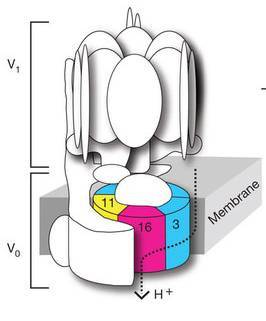 Much of what living cells do is carried out by "molecular machines" - physical complexes of specialized proteins working together to carry out some biological function. How the minute steps of evolution produced these constructions has long puzzled scientists, and provided a favorite target for creationists.
Much of what living cells do is carried out by "molecular machines" - physical complexes of specialized proteins working together to carry out some biological function. How the minute steps of evolution produced these constructions has long puzzled scientists, and provided a favorite target for creationists.
To probe this puzzle, Thornton and his team reconstructed the evolution of one such molecular machine, a "proton pump" that maintains acidity in cellular compartments in many species. This machine includes a subunit made of six proteins forming a ring (colored in figures). These six proteins usually exist in two kinds, but in fungi the ring has three kinds of proteins. How did the increased complexity of the fungal version evolve, they ask. This evolutionary step apparently took place more than 800 million years ago, so it is obscured in the deep past. We admire their work to make this reconstruction plausible.
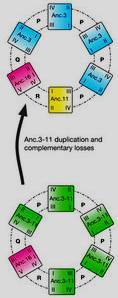 The geneticists conclude that, following gene duplications, paralogs of an original protein underwent mutations and diverged slightly. Only one or two amino acid substitutions reduced their capability to link together as before — a loss-of-function. After that, the proteins could link together only in a specific order to complete the ring structure. That is the likeliest explanation for the complication of the fungal version of the six-protein ring. (The logic is well illustrated in commentary by molecular biologist W. Ford Doolittle, and further elaborated in a subsequent article by Deeds et al.) Following this reconstruction of events, Thornton comments,
The geneticists conclude that, following gene duplications, paralogs of an original protein underwent mutations and diverged slightly. Only one or two amino acid substitutions reduced their capability to link together as before — a loss-of-function. After that, the proteins could link together only in a specific order to complete the ring structure. That is the likeliest explanation for the complication of the fungal version of the six-protein ring. (The logic is well illustrated in commentary by molecular biologist W. Ford Doolittle, and further elaborated in a subsequent article by Deeds et al.) Following this reconstruction of events, Thornton comments,
"Gene duplications happen frequently in cells, and it's easy for errors in copying to DNA to knock out a protein's ability to interact with certain partners. It's not as if evolution needed to happen upon some special combination of 100 mutations that created some complicated new function." Thornton proposes that the accumulation of simple, degenerative changes over long periods of times could have created many of the complex molecular machines present in organisms today. (John Eastman, press release, linked below.)
We are relieved to know that darwinists have been puzzled by something nontrivial, but we think the new analysis does not justify Thornton's broad conclusion. First, the slightly more complicated fungal protein pump does no more than the simpler version did, so no new function was gained. More importantly, the conclusion ignores something obvious. Paralogs that vary slightly from the original are ubiquitous and easy to explain, but the first version, the "original," remains unexplained. While paralogs relate to each other, the whole family usually lies well-isolated (>100 mutations removed?) in nucleotide sequence space. If it were not so, identifying and naming gene families would be much more difficult. In brief, the divergence of paralogs does nothing to explain the existence of a paralog family. And the divergence of these specific proteins does not in any way account for the creation of the proton pump of which they are parts.
This research is quite commendable, but its implications are being exaggerated. The apparent motive for this exaggeration it to suppress criticism, as hinted in the media release. But understanding the world is the proper motive for science. When understanding is adequate, criticism does not need suppression.
 Gregory C. Finnigan, Victor Hanson-Smith et al., "Evolution of increased complexity in a molecular machine" [abstract], doi:10.1038/nature10724, Nature, online 9 Jan 2012. Gregory C. Finnigan, Victor Hanson-Smith et al., "Evolution of increased complexity in a molecular machine" [abstract], doi:10.1038/nature10724, Nature, online 9 Jan 2012.
 W. Ford Doolittle, "...A ratchet for protein complexity" [html], doi:10.1038/nature10816, Nature, online 9 Jan 2012. W. Ford Doolittle, "...A ratchet for protein complexity" [html], doi:10.1038/nature10816, Nature, online 9 Jan 2012.
 Eric J. Deeds et al., "Optimizing ring assembly reveals the strength of weak interactions" [abstract], doi:10.1073/pnas.111309510, Proc. Natl. Acad. Sci. USA, online 30 Jan 2012. Eric J. Deeds et al., "Optimizing ring assembly reveals the strength of weak interactions" [abstract], doi:10.1073/pnas.111309510, Proc. Natl. Acad. Sci. USA, online 30 Jan 2012.
 Evolution of complexity recreated using 'molecular time travel' by John Easton, University of Chicago Medical Center, 8 Jan 2012. Evolution of complexity recreated using 'molecular time travel' by John Easton, University of Chicago Medical Center, 8 Jan 2012.
 A Blind Man Carrying a Legless Man Can Safely Cross the Street by Michael J. Behe, 11 Jan 2012. A Blind Man Carrying a Legless Man Can Safely Cross the Street by Michael J. Behe, 11 Jan 2012.
 Macroevolutionary Progress Redefined: Can It Happen Without Gene Transfer? is a related local webpage. It mentions an instance of gene duplication and divergence that apparently did confer an enhanced capability, tri-chromatic vision. Macroevolutionary Progress Redefined: Can It Happen Without Gene Transfer? is a related local webpage. It mentions an instance of gene duplication and divergence that apparently did confer an enhanced capability, tri-chromatic vision.
 Testing Darwinism versus Cosmic Ancestry is a related local webpage. Testing Darwinism versus Cosmic Ancestry is a related local webpage.
 Neo-Darwinism: The Current Paradigm is a related local webpage. Neo-Darwinism: The Current Paradigm is a related local webpage.
 Thanks for alerts, Stan Franklin and Hans-Peter Wheeler. Thanks for alerts, Stan Franklin and Hans-Peter Wheeler.
![]()
|

 ...we must begin seriously to consider whether the course of Evolution can at all reasonably be represented as an unpacking of an original complex which contained within itself the whole range of diversity which living things present. — William Bateson, in the Presidential Address at the Australian meeting of the British Association for the Advancement of Science, 1914.
...we must begin seriously to consider whether the course of Evolution can at all reasonably be represented as an unpacking of an original complex which contained within itself the whole range of diversity which living things present. — William Bateson, in the Presidential Address at the Australian meeting of the British Association for the Advancement of Science, 1914.
 "The origin of the exquisitely complex vertebrate brain is somewhat mysterious. 'In terms of evolution, it basically pops up out of nowhere. You don’t see anything anatomically like it in other animals,' says Ariel Pani, an investigator at the Marine Biological Laboratory (MBL) in Woods Hole and a graduate student at the University of Chicago.
"The origin of the exquisitely complex vertebrate brain is somewhat mysterious. 'In terms of evolution, it basically pops up out of nowhere. You don’t see anything anatomically like it in other animals,' says Ariel Pani, an investigator at the Marine Biological Laboratory (MBL) in Woods Hole and a graduate student at the University of Chicago.

 Although we've found amino acids in carbon-rich meteorites before, we weren't expecting to find them in these specific groups, since the high temperatures they experienced tend to destroy amino acids — Dr. Aaron Burton, NASA.
Although we've found amino acids in carbon-rich meteorites before, we weren't expecting to find them in these specific groups, since the high temperatures they experienced tend to destroy amino acids — Dr. Aaron Burton, NASA.
 ...We show that fundamental elements of the C4 pathway in the grass lineage Alloteropsis were acquired via a minimum of four independent lateral gene transfers from C4 taxa that diverged from this group more than 20 million years ago. The transfer of genes that were already fully adapted for C4 function has occurred periodically over at least the last 10 million years and has been a recurrent source for the optimization of the C4 pathway. This report shows that plant-plant lateral nuclear gene transfers can be a potent source of genetic novelty and adaptation in flowering plants.
...We show that fundamental elements of the C4 pathway in the grass lineage Alloteropsis were acquired via a minimum of four independent lateral gene transfers from C4 taxa that diverged from this group more than 20 million years ago. The transfer of genes that were already fully adapted for C4 function has occurred periodically over at least the last 10 million years and has been a recurrent source for the optimization of the C4 pathway. This report shows that plant-plant lateral nuclear gene transfers can be a potent source of genetic novelty and adaptation in flowering plants. An insect species acquired a beneficial gene from bacteria by horizontal gene transfer (HGT). Coffee berry borer beetles (example on a bean, pictured) harbor the bacteria in their guts. The acquired gene enables the beetle to digest complex sugars in the beans. In standard evolutionary theory, this phenomenon is considered remarkable, whereas in cosmic ancestry, HGT is necessary to drive evolutionary progress. And this example is only one among many noticed in the last few decades. We wish standard evolutionary theory would pay more attention.
An insect species acquired a beneficial gene from bacteria by horizontal gene transfer (HGT). Coffee berry borer beetles (example on a bean, pictured) harbor the bacteria in their guts. The acquired gene enables the beetle to digest complex sugars in the beans. In standard evolutionary theory, this phenomenon is considered remarkable, whereas in cosmic ancestry, HGT is necessary to drive evolutionary progress. And this example is only one among many noticed in the last few decades. We wish standard evolutionary theory would pay more attention. First Contact, by Washington Post science reporter Marc Kaufman, is well worth reading. He is genuinely interested in the possibility of life elsewhere, and he digs deeply into the details. To do this, he has spent time with many of the frontline researchers, and he shares those experiences vividly. The researchers come from a variety of fields, like extremophiles, SETI, extrasolar planets and, of course, life on Mars. We enjoyed learning more, for example, about Michael Mumma and his painstaking detection of methane on Mars. And we especially liked Chapter 6: "Three Eurekas on Hold," about the discoveries of David McKay, Richard Hoover and Gil Levin. We know them well, and think all three deserve to be better understood. Here Kaufman is a bit too even-handed for us, but that keeps him from seeming prejudicial, so, good. Recommended.
First Contact, by Washington Post science reporter Marc Kaufman, is well worth reading. He is genuinely interested in the possibility of life elsewhere, and he digs deeply into the details. To do this, he has spent time with many of the frontline researchers, and he shares those experiences vividly. The researchers come from a variety of fields, like extremophiles, SETI, extrasolar planets and, of course, life on Mars. We enjoyed learning more, for example, about Michael Mumma and his painstaking detection of methane on Mars. And we especially liked Chapter 6: "Three Eurekas on Hold," about the discoveries of David McKay, Richard Hoover and Gil Levin. We know them well, and think all three deserve to be better understood. Here Kaufman is a bit too even-handed for us, but that keeps him from seeming prejudicial, so, good. Recommended. Plant tissue frozen in Siberia for 32,000 years has been revived to produce a flowering plant bearing viable seeds. The tissue came from fruit stored in the burrow of an arctic ground squirrel; radiocarbon dating confirms the age of the tissue. The plant, a campion (pictured), is being cultivated by bologists at the Institutes of Cell Biophysics and Physicochemical and Biological Problems in Soil Science at the Russian Academy of Sciences. They write, This revival reinforces other evidence showing that dormant life can remain viable for very long times...."
Plant tissue frozen in Siberia for 32,000 years has been revived to produce a flowering plant bearing viable seeds. The tissue came from fruit stored in the burrow of an arctic ground squirrel; radiocarbon dating confirms the age of the tissue. The plant, a campion (pictured), is being cultivated by bologists at the Institutes of Cell Biophysics and Physicochemical and Biological Problems in Soil Science at the Russian Academy of Sciences. They write, This revival reinforces other evidence showing that dormant life can remain viable for very long times...."
 Instruments, Methods, and Missions for Astrobiology XV, sponsored by SPIE, the international society for optics and photonics, will be held in San Diego, 12-16 August. Conference Chairs are Richard B. Hoover, NASA Marshall Space Flight Center.; Gilbert V. Levin, Arizona State University; Alexei Yu. Rozanov, Paleontological Institute (Russian Federation); and Paul C. W. Davies, Arizona State University.
Instruments, Methods, and Missions for Astrobiology XV, sponsored by SPIE, the international society for optics and photonics, will be held in San Diego, 12-16 August. Conference Chairs are Richard B. Hoover, NASA Marshall Space Flight Center.; Gilbert V. Levin, Arizona State University; Alexei Yu. Rozanov, Paleontological Institute (Russian Federation); and Paul C. W. Davies, Arizona State University. A Russian team drilling in Antarctica reached the water of Lake Vostok at a depth of 12,366 feet (3,769 meters) on Sunday. About the size of Lake Ontario, the lake has been trapped in the cold and dark under ice for some 20 million years. So isolated, its environment is comparable to that under the ice on Jupiter's moon Europa or Saturn's Enceladus. If evidence of life is found in the water of Lake Vostok, life in the oceans on those moons and elsewhere in the universe will seem more likely.
A Russian team drilling in Antarctica reached the water of Lake Vostok at a depth of 12,366 feet (3,769 meters) on Sunday. About the size of Lake Ontario, the lake has been trapped in the cold and dark under ice for some 20 million years. So isolated, its environment is comparable to that under the ice on Jupiter's moon Europa or Saturn's Enceladus. If evidence of life is found in the water of Lake Vostok, life in the oceans on those moons and elsewhere in the universe will seem more likely.
 These two self-described "paleovirologists" are initially interested in reconciling the conflicting ages of viruses given by different methods. The observed mutation rate indicates they are young, but distribution among long-diverged species suggests they are old. The two researchers conclude that viruses are old: In many cases in which EVEs that are closely related to modern viruses could be dated, the minimum age inferred for the most recent ancestor of the viral family has turned out to be far older than was previously estimated using sequence data from circulating viruses.
These two self-described "paleovirologists" are initially interested in reconciling the conflicting ages of viruses given by different methods. The observed mutation rate indicates they are young, but distribution among long-diverged species suggests they are old. The two researchers conclude that viruses are old: In many cases in which EVEs that are closely related to modern viruses could be dated, the minimum age inferred for the most recent ancestor of the viral family has turned out to be far older than was previously estimated using sequence data from circulating viruses.

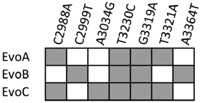


 The drilling took 20 years, and preventing contamination of the lake was a major concern. When the lake was penetrated, water rushed upward into the borehole as expected, flushing the drilling fluid and its potential contamnants away. This water then quickly froze, sealing contaminants out. The testing of water samples is postponed until spring returns to Antarctica.
The drilling took 20 years, and preventing contamination of the lake was a major concern. When the lake was penetrated, water rushed upward into the borehole as expected, flushing the drilling fluid and its potential contamnants away. This water then quickly froze, sealing contaminants out. The testing of water samples is postponed until spring returns to Antarctica. Much of what living cells do is carried out by "molecular machines" - physical complexes of specialized proteins working together to carry out some biological function. How the minute steps of evolution produced these constructions has long puzzled scientists, and provided a favorite target for creationists.
Much of what living cells do is carried out by "molecular machines" - physical complexes of specialized proteins working together to carry out some biological function. How the minute steps of evolution produced these constructions has long puzzled scientists, and provided a favorite target for creationists.
 The geneticists conclude that, following gene duplications, paralogs of an original protein underwent mutations and diverged slightly. Only one or two amino acid substitutions reduced their capability to link together as before — a loss-of-function. After that, the proteins could link together only in a specific order to complete the ring structure. That is the likeliest explanation for the complication of the fungal version of the six-protein ring. (The logic is well illustrated in commentary by molecular biologist W. Ford Doolittle, and further elaborated in a subsequent article by Deeds et al.) Following this reconstruction of events, Thornton comments,
The geneticists conclude that, following gene duplications, paralogs of an original protein underwent mutations and diverged slightly. Only one or two amino acid substitutions reduced their capability to link together as before — a loss-of-function. After that, the proteins could link together only in a specific order to complete the ring structure. That is the likeliest explanation for the complication of the fungal version of the six-protein ring. (The logic is well illustrated in commentary by molecular biologist W. Ford Doolittle, and further elaborated in a subsequent article by Deeds et al.) Following this reconstruction of events, Thornton comments,